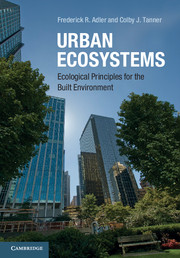3 - Urban ecosystem processes
Published online by Cambridge University Press: 05 May 2013
Summary
The urban metabolism and the urban energy budget quantify one of our themes, the increased inputs and outputs characteristic of urban areas. The ecological footprint broadly quantifies another theme, the extent of habitat modification in the built environment. These analyses establish the background for detailed examination of our third theme, the intended and unintended consequences of human action for the functioning of the urban ecosystem. This chapter focuses on ecosystem ecology, tracing how urbanization alters the movement and use of materials and energy.
The following principles (Figure 3.1), expanding on those in Section 1.4, organize our discussion of three key forms of material and energy that characterize an urban ecosystem: temperature, water, and nutrients.
Ecosystem processes depend on cycles, how materials and energy move between locations and transform into different states.
The basic physical properties of a material or form of energy determine how it is stored, recycled, and transformed.
The basic biological properties of a material or form of energy determine the role of living organisms in its storage, transformation, and loss.
The habitat, including both its physical structure and the organisms that live there, shapes ecosystem cycles.
Different ecosystem cycles interact with each other, often in unexpected ways.
Processes occurring at one point in space or time are linked with those operating at other locations or times.
- Type
- Chapter
- Information
- Urban EcosystemsEcological Principles for the Built Environment, pp. 74 - 138Publisher: Cambridge University PressPrint publication year: 2013



